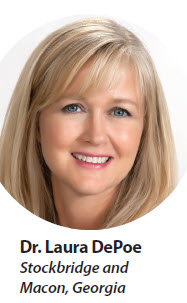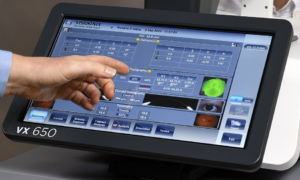Sponsored Content
By ROB Editors & Laura DePoe, OD
Independent practitioners are leaving money on the table. Take a look at these numbers from VisionWatch, The Vision Council Q4 2021 analysis: Independent practices only capture 26.7 percent of frame sales and 39.8 percent lens sales – resulting in significant revenue opportunity walking out the door with Rx in hand.
It might be easy to say that sunglasses, OTC readers and even contact lenses have become commodities, but the point is that your patients are going elsewhere to buy these products. And it adds up. The average frame price in Q4 2021 was $127.58 and the average lens price was $166.27, according to The Vision Council’s Vision Care Market Quarterly Overview. So that’s about a $293.85 sale, on average. The average purchase in an optometry practice upon a cardholder opening a CareCredit account is $769 in out-of-pocket spend (after insurance and discounts).*

Run similar scenarios for your contact lens patients. If half of them are not buying their contact lenses from you, what is that costing you? Remember that these are average sales. Many independent practitioners pride themselves on offering their patients the highest quality and newest technology products, which also carry premium price tags. These include newer designs and materials in daily disposable, multifocal and toric soft contact lenses; digitally surfaced ophthalmic lenses; high-quality, anti-reflective treatments; and new progressive designs and beneficial add-ons, such as polarization and protection against harmful UV and blue light. Remember, too, that patients are looking for a complete solution based on all of their visual needs.
Such a recommendation often includes multiple pairs of eyewear, such as prescription sunglasses, computer lenses, sports eyewear and eyeglasses designed to meet the specific requirements of certain hobbies or work tasks. In other words, there are two compelling reasons to focus on your patients’ complete visual needs: they’ll be more satisfied, and you’ll capture the profit.
 Capturing What You’re Losing: Connecting Patient Needs to What You Can Provide Them With
Capturing What You’re Losing: Connecting Patient Needs to What You Can Provide Them With
Laura DePoe, OD, who, along with her husband, Adam DePoe, OD, owns DePoe Eye Center in Stockbridge and Mason Ga., didn’t at first connect her conversation on patients’ needs and eye health with the products available in the dispensary—until a conversation years ago with a patient showed her why it’s necessary. “I consider myself more of a nurturer or caregiver than a salesperson. So I didn’t feel like I needed to say that we had special features on our ophthalmic lenses, for example. But one patient told me about new eyeglasses with advanced features that her friend had purchased, “but I didn’t have that option.” At that moment, Dr. DePoe realized that she could have remedied that perception if she spent just a few seconds saying, “We have new lenses available that will address these issues for you.”
Now she’s more comfortable talking specifically about how a product benefits patients. “I recommend, based on a clinical standpoint, what is healthy and good for patients’ eyes. Then I note that we have access to these products right here,” she says. Michelle Wright, practice director at DePoe Eye Center, says that recommendation in the exam room also makes it easier to finalize the sale in the optical. Opticians can reinforce what the doctor has told them—and they make it a point to address the CareCredit credit card option to every patient. “We have a phrase that we use every time. We say, ‘We’re excited to offer you the ability to pay for this in monthly installments using special financing.’ We say this right at the start of the eyewear selection process so that they don’t feel limited by what funds they have available. We don’t want them to feel like they have to sacrifice features or benefits,” Wright says. “With special financing through CareCredit, we can help fill just about anyone’s needs at a monthly payment level they can afford.”
Making this offer early in the process makes a difference, she adds. “We see patients choosing more features than they might have in the past. We see more people purchasing second pairs or prescription sunwear because they have months to pay for it.”
The practice brought the CareCredit option to patients almost a decade ago. One of the managers had used her own CareCredit credit card for her veterinary expenses and saw how the special financing would be applicable at the practice, too. More recently, the practice’s billing manager, Jessica Diver, has begun promoting it more. That increased exposure—on the practice’s website, social media and in the office—has increased the uptake from patients noticeably, Wright says.
*Average 2020 first-ticket sale in independent optometry practices that accepts CareCredit

























